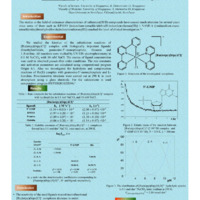Equilibrium and kinetic studies of the reactions between [Ru(terpy)(bipy)Cl]Cl complex and biologically important N-donor ligands
Објеката
- Тип
- Саопштење са скупа штампано у изводу
- Верзија рада
- објављена
- Језик
- енглески
- Креатор
- Aleksandar Mijatović, Biljana Petrović, Ratomir Jelić, Živadin Bugarčić
- Извор
- EuroAnalysis 16 - Challenges in Modern Analytical Chemistry
- Издавач
- Belgrade : Division of Analytical Chemistry of the Serbian Chemical Society
- Датум издавања
- 2011
- Сажетак
-
Studije u oblasti antikancerogenih karakteristika jedinjenja rutenijuma(III/II) izazivaju veliku pažnju već nekoliko godina otkako su neka od njih kao što su KP1019 (indazolijum-tetrahloridobis(H-indazol)rutenat(III)) i NAMI-A (imidazolijum) -trans-tetrahlorido(dimetilsulfoksid)indazolerutenat(III)) dostigao nivo kliničkog ispitivanja. Kompleksi rutenijuma u reakciji sa molekulom DNK formiraju prvenstveno gvanin- i adenin-adukt, kao komplekse platine. Takođe, nekoliko studija ukazuje na veoma jake interakcije sa proteinima. Međutim, kompleksi Ru(III/II) pokazuju generalno manje toksične efekte od lekova platine(II).1
Proučavali smo kinetiku reakcija supstitucije kompleksa [Ru(terpi)(bipi)Cl]Cl sa biološki važnim ligandima: dimetilsulfoksidom, gvanozin-5’-monofosfatom, tioureom i L-histidinom. Sve reakcije su proučavane UV-VIS spektrofotometrijom u 0,1 M NaClO4 sa 10 mM NaCl. Veće koncentracije liganada su korišćene da bi se obezbedili uslovi pseudo prvog reda. Konstante brzine i aktivacioni parametri su izračunavani korišćenjem računarskog programa Origin 6.1. Takođe smo istraživali reakcije hidrolize i kompleksiranja Ru(II) kompleksa sa gvanozin-5’-monofosfatom i L-histidinom. Potenciometrijske titracije su izvedene na 298 K u inertnoj atmosferi korišćenjem staklene elektrode. Za proračune je korišćen računarski program HIPERKUAD. -
The studies in the field of anticancer characteristics of ruthenium(III/II) compounds have caused much attention for several years since some of them such as KP1019 (indazolium-tetrachloridobis(H-indazole)ruthenate(III)) i NAMI-A (imidazolium-trans-tetrachlorido(dimethylsulfoxide)indazoleruthenate(III)) reached the level of clinical investigation. Ruthenium complexes in the reaction with DNA molecule form preferentially the guanine- and adenine-adduct, as platinum complexes. Also, several studies indicate very strong interactions with proteins. However, Ru(III/II) complexes show generally less toxic effects than platinum(II) drugs.1
We studied the kinetics of the substitution reactions of [Ru(terpy)(bipy)Cl]Cl complex with biologically important ligands: dimethylsulfoxide, guanosine-5’-monophosphate, thiourea and L-histidine . All reactions were studied by UV-VIS spectrophotometry in 0.1 M NaClO4 with 10mM NaCl. The excess of ligand concentration was used to observed pseudo-first order conditions. The rate constants and activation parameters are calculated using computational program Origin 6.1. Also we investigated the hydrolysis and complexation reactions of Ru(II) complex with guanosine-5’-monophosphate and L-histidine. Potentiometric titrations were carried out at 298 K in inert atmosphere using a glass electrode. For the calculations is used computation program HIPERQUAD.
- Шира категорија рада
- М30
- Ужа категорија рада
- М34
- Права
- Отворени приступ
- Лиценца
- Creative Commons – Attribution-NonComercial-No Derivative Works 4.0 International
- Формат
- .doc
Aleksandar Mijatović, Biljana Petrović, Ratomir Jelić, Živadin Bugarčić. "Equilibrium and kinetic studies of the reactions between [Ru(terpy)(bipy)Cl]Cl complex and biologically important N-donor ligands" in EuroAnalysis 16 - Challenges in Modern Analytical Chemistry, Belgrade : Division of Analytical Chemistry of the Serbian Chemical Society (2011) М34
This item was submitted on 9. децембар 2021. by [anonymous user] using the form “Рад у зборнику радова” on the site “Радови”: http://romeka.rgf.rs/s/repo
Click here to view the collected data.
